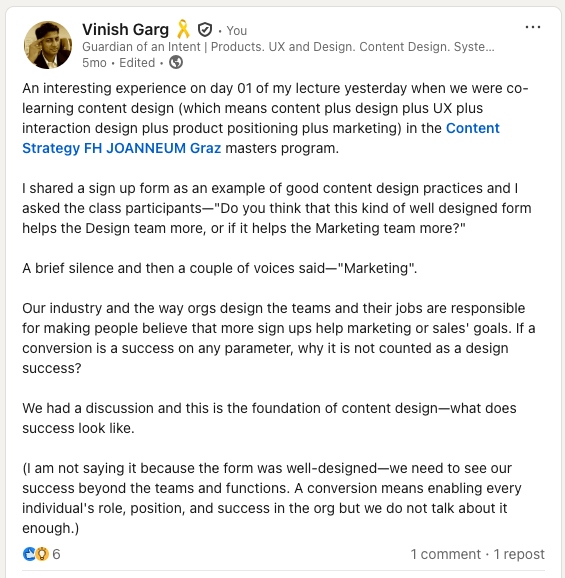While teaching content design in the masters program in FH JOANNEUM, in Graz, Austria, I start it by making the participants understand what is orgization design, why they start, how they define goals, and why they want to make digital products. You cannot learn content design by learning about content only.
The participants in this program are already working in the industry in different roles—content manager, project manager, interaction designer, UX writer, social media content strategist, content marketer, and other roles. My job is to set up a broad context of the role of content in an organization, in their systems, and in products and UX, regardless of their current role or position, and regardless of the orgnization size, scale, business model, and the domain.
My goal is this program is to build their capacity—to make them understand that learning content design is learning about the products.
We do not talk about content specific skills early in the program. For example when we discuss discovery, or synthesis and convergence, or user stories and JTBD, it is not only about the content—content serves as a support function to everything else that different teams are trying to build or achieve.
I use a lot of real world examples of products for different use cases, and I also use industry references to support my opinion and thoughts about a practice or an opportunity. The participants can see how design often serves as a patchwork in the digital products when they do not have a content designer in the organization. Here are my slides from day 3 in the program.
Our discussions are about:
—Digital products experience—the positioning, customer onboarding, product metrics, content ROI frameworks, how customers make sense of an organization’s mission while using a product, the design systems, the interaction design, the content strategy and the brand voice, the job stories, the synthesis of user research, the search experience, and the product features prioritization exercise, the content life cycle, and the product lifecycle
—How we work, our mental models, our decision models, our belief system, the content and design standards and principles, how to build education, advocacy, and influence, the marketing is fragmented and design is fractured in the absence of content design or content strategy, and how to build our product sense and the judgment to identify the content and design opportunities for the product goals
—How to learn, how to find or design the incentives to learn, how to apply those learnings at work
—How our work in content design brings more order, structure, calmness, joy, and merit in the work of all the teams and functions in an organization
Sometimes I share these experiences on LinkedIn, here is an example.

After teaching in this program for a few years and since I have run my own independent courses in content and UX, I always feel happy to see how the participants have their own learning models. My job is to build their confidence so that they can ask lot of questions in the sessions. One participant wrote to me—”I might not have learnt content design but I know why every product team should definitely have a content designer.”
This is my gain.
